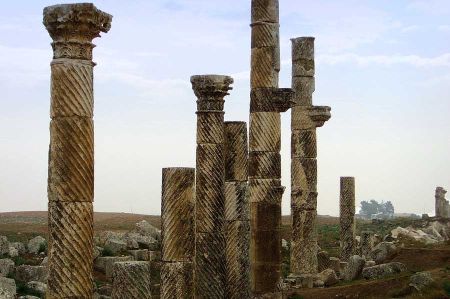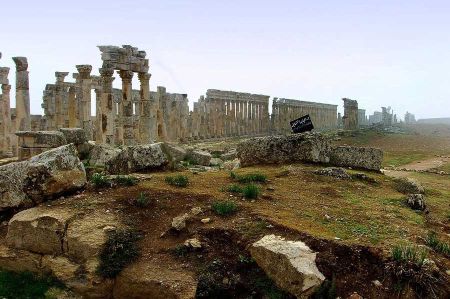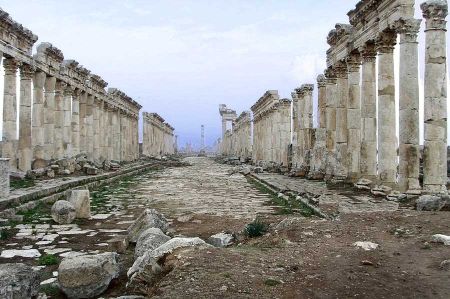Pharnakes - later Apamea on the Orontes river
- Written by Portal Editor
Apamea on Orontes river: Originally the city was called Pharnakes, after the conquest by Alexander the Great it was also called Pella for a short time.
The constant establishment of new cities made it difficult to find the right name for a young city. In the past, it was often common for city founders to simply repeat a previously chosen and thus already existing city name or to use an existing name, the same applies to Pharnakes: Emperors and kings as city founders had no problem with the city name itself even it appeared several times in their empire. This also applies to the city name Apamea. For better differentiation today, an addition to the name or another place name (on the Orontes) is usually added.
Pharnakes becomes Apamea on the Orontes
The city of Apamea on the Orontes, originally known with the name of Pharnakes, can refer to such a history of several thousand years and due to that is one of the oldest cities of mankind. Unfortunately, due to constant conflicts in the border region in northern Syria, the excavations have not progressed so far that many details of the city's history are known. The Belgian Franz Cumont was able to uncover parts of the old town between 1930 and 1938, then between 1947 and 1953. It was not until 1965 that excavations took place in Apamea under the direction of Jean Charles Balty. Today some artefacts are stored in the museum "Musées Ryaux d’Art et d’Histoire" in Brussels, including a large number of well-preserved mosaics.
When Apamea was conquered by Alexander the Great around 333 BC and was badly destroyed in the process, another new name for the city briefly appeared in history: Pella, the capital of the Apamene region. Just a few years later, the Seleucid king Seleukos I Nikator (312 - 281 BC) was able to take over the city.
 The first Seleucid king, Seleukos I Nikator, and his wife Apame, a daughter of Spitamenes, were then able to choose a new name. With a large number of new buildings and the privilege of being a mint, Seleukos I named the city “Apameia” due to his wife´s name Apame. The city founder Seleukos also had built a citadel on a nearby hill, which is now called Qal'at al-Mudiq. This became the seat of the crusaders at the beginning of the 12th century but was recaptured by Nur ad-Din in 1149.
The first Seleucid king, Seleukos I Nikator, and his wife Apame, a daughter of Spitamenes, were then able to choose a new name. With a large number of new buildings and the privilege of being a mint, Seleukos I named the city “Apameia” due to his wife´s name Apame. The city founder Seleukos also had built a citadel on a nearby hill, which is now called Qal'at al-Mudiq. This became the seat of the crusaders at the beginning of the 12th century but was recaptured by Nur ad-Din in 1149.
The Orontes River - an important factor in the laying of the foundation stone
The ancient city of Pharnakes was founded on a plateau above the Orontes River, an approximately 450-kilometer-long river that flows through today's Lebanon, Syria and Turkey. The largest possible area on the plateau was about 200 hectares, which was later completely surrounded by a city wall. Until a few years ago, the ancient column street from the 2nd century, at least 1,600 meters long, which still had a large number of standing column fragments, was one of the buildings worth seeing. The theatre and some church buildings were also well preserved.
The Orontes is one of the oldest rivers that was dammed by humans at an early stage. The historian Strabo already tells of the dams used by the Egyptians for damming the water. Today's Lake Homs goes back to a dam built by the Romans who dammed the Orontes near Quattinah. Similar records can also be found in Pliny. Among other things, the legendary battle of Kadesch in 1274 BC between Ramses II and the Hittite king Muwatalli II, which took place on the Orontes, is reported.
Pompey destroys the fortress of Apamea
 Shortly before the middle of the 1st century BC Pompey destroyed the fortress, and Apamea was re-born in 63 BC. As part of the new Roman province of Syria. Then the city was raised to a Roman citizen colony under the name Colonia Claudia Apamea. The cityscape also included numerous temples, a nymphaeum, a palace complex, magnificent Roman villas and several church buildings. In the west of the city a theatre was built, with a diameter of 139 m it was the largest in Syria.
Shortly before the middle of the 1st century BC Pompey destroyed the fortress, and Apamea was re-born in 63 BC. As part of the new Roman province of Syria. Then the city was raised to a Roman citizen colony under the name Colonia Claudia Apamea. The cityscape also included numerous temples, a nymphaeum, a palace complex, magnificent Roman villas and several church buildings. In the west of the city a theatre was built, with a diameter of 139 m it was the largest in Syria.
As the Bible says, the Romans have always been very interested in statistics for a variety of reasons. A census by the Syrian governor Publius Sulpicius Quirinius in 6 and 7 AD is said to have shown that 117,000 free men were living in Apamea at the time of the census. If this number is just approximately correct, one can assume that the population must have been around half a million people. This would make Apamea one of the largest cities in the Orient.
A well-known philosophy school was located in Apamea under the Byzantines during late antiquity. The city also had a huge circus building. In 540 AD, Apamea surrendered without a fight to the advancing Persians under their leader Chosrau I, but was won back a little later by Emperor Justinian, who then had the castle fortified. In the 7th century, Apamea was finally conquered by Muslim forces, and in the years 636 to 638 it was largely plundered and destroyed. In the centuries that followed, mostly just the fortress itself remained inhabited.
During the Syrian civil war, famous street of columns was taken under artillery fire on March 15, 2012. In the spring of 2013, aerial photos accessible on GoogleEarth showed a severe destruction of the archaeological site by large robbery excavation holes that were specifically created to supply the illegal antique market with new goods. Heavily armed, organized gangs with international contacts are predominantly responsible for this.
Please also read:
Aventicum - amphitheatre and Roman theatre beckon
The Ottomans are leaving Belgrade - a city in transition
